My first book of 2023 is The Wood Age: How wood shaped the whole of human history by Roland Ennos, a history of wood and human society.
The book is divided into four parts “pre-human” history, up to the industrial era, the industrial era and “now and the future”.
Part one covers our ancestors’ life in the trees and descent from them. Ennos argues that nest building as practised by, for example, orangutans is a sophisticated and little recognised form of tool use and involves an understanding of the particular mechanical properties of wood. Descending from the trees, Ennos sees digging sticks and fire as important. Digging sticks are effective for rummaging roots out of the earth, which is handy if you moving away from the leaves and fruits of the canopy. Wood becomes harder with drying (hence making better digging sticks), and the benefits of cooking food with (wood-based) fire are well-reported. The start of controlled use of fire is unknown but could be as long ago as 2,000,000 years. The final step – hair loss in humans – Ennos attributes to the ability to build wooden shelters, this seems rather farfetched to me. I suspect this part of the book is most open to criticism since it covers a period well before writing, and with very little fossilised evidence of the key component.
The pre-human era featured some use of tools made from wood, and this continued into the “stone” age but on the whole wood is poorly preserved over even thousands of years. The oldest wooden tools discovered dates to 450,000 years ago – a spear found in Essex. The peak of tool making in the Neolithic is the bow and arrow – as measured by the number of steps required, and materials, required.
The next part of the book covers the period from the Neolithic through to the start of the Industrial Revolution. In this period ideas about farming spread to arboriculture, with the introduction of coppicing which produces high yields of fire wood, and wood for wicker which is a new way of crafting with wood. There is some detailed discussion on how wood burns, and how the introduction of charcoal, which burns hotter is essential to the success of the “metal” ages and progressing from earthenware pottery (porous and weak) to stoneware, which is basically glassy and requires a firing temperature of over 1000 celsius. As an aside, I found it jarring that Ennos quoted all temperatures in Fahrenheit!
This section has the air of describing a technology tree in a computer game. The ability to make metal tools, initially copper then bronze then iron then steel, opens up progressively better tools and more ways of working with wood, like sawing planks which can be used to make better boats than those constructed by hollowing out logs or splitting tree trunks. Interestingly the boats made by Romans were not surpassed in size until the 17th century.
Wheels turn out to be more complicated than I first thought, slicing a tree trunk into disks doesn’t work because the disks split in use (and in any case cutting cleanly across the grain of wood is hard without a steel-bladed saw). The first wheels, three planks cut into a circle and held together with battens, are not great. The peak of wheel building is the spoked wheel which requires steam bent circumference, turned spokes and a turned central hub with moderately sophisticated joints. Ennos argues that the reason South America never really took to wheels, and the Polynesians did not build plank built boats was a lack of metals appropriate for making tools.
Harder, steel tools also enabled the carpentry of seasoned timber – better for making furniture than greenwood which splits and deforms as it dries.
Ultimately the use of wood was not limited by the production of wood but rather by transport and skilled labour. The Industrial Revolution picks up when coal becomes the fuel of choice – making manufacturing easier, and allowing cities to grow larger.
The final substantive part of the book covers the Industrial Revolution up to the present. This is largely the story of the replacement of wood as fuel with coal, wood as charcoal (used in smelting) with coke (which is to coal what charcoal is to wood), and the replacement of many small wood items with metal, ceramic, glass and more recently plastic. It is not a uniform story though, England moved to coal as a fuel early in the 19th century – driven by an abundance of coal, a relative shortage of wood, and the growth of large cities. Other countries in Europe and the US moved more slowly. The US built its railways with wooden infrastructure (bridges and sleepers), rather than the stone used in Britain, for a much lower cost. The US still tends to build domestic buildings in wood. The introduction of machine made nails and screws in the late 18th century makes construction in wood a lower skilled activity. Paper based on wood was invented around 1870, making newspapers and books much cheaper.
In the 21st century wood and processed-wood like plywood or chipboard are still used for many applications.
The final part of the book is a short look into the future, mainly from the point of view of re-forestation. I found this a bit odd because it starts complaining about the “deforestation myth” but then goes on to outline when humans caused significant deforestation and soil erosion damage.!
Ennos sees wood as an under-reported factor in the evolution of humanity, but authors often feel their topic is under-reported. I suppose this is inevitable since these are people so passionate about their topic that they have devoted their energy to writing a whole book about it.
This is a nice read, not too taxing but interesting.





 The clock and the camshaft
The clock and the camshaft